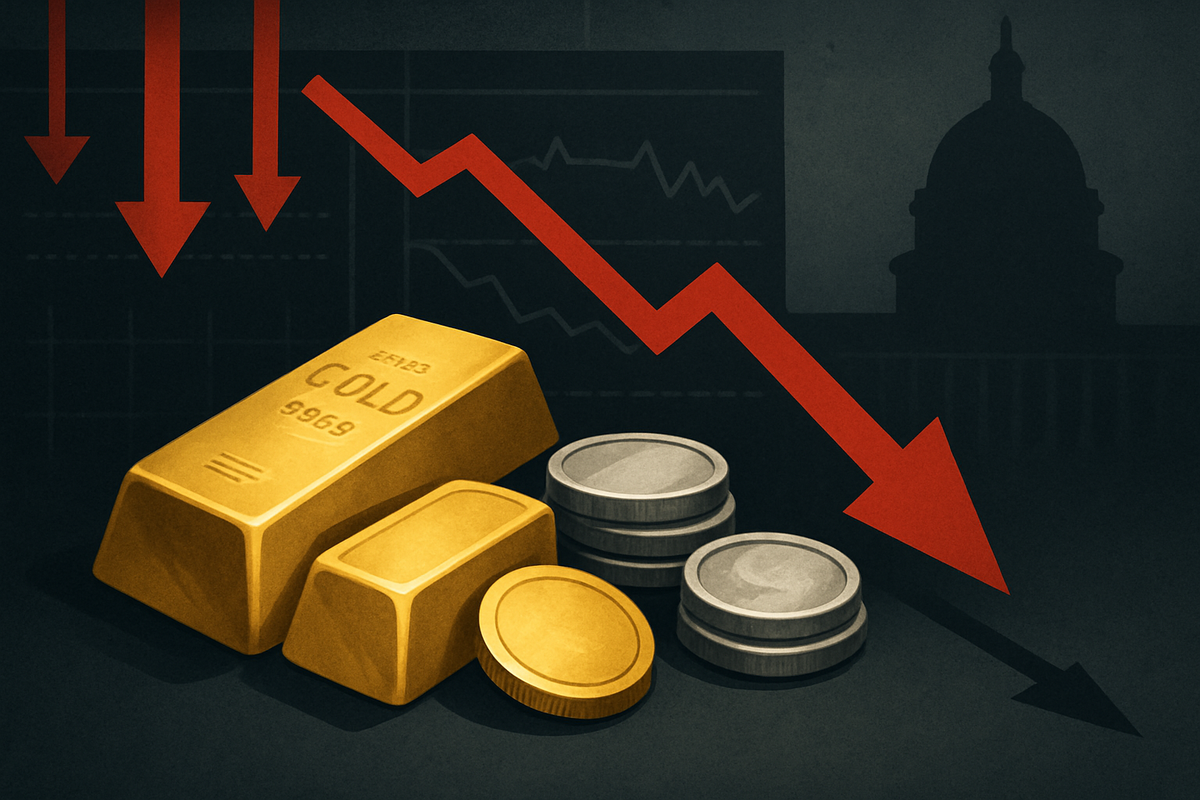
Precious metals, long considered the ultimate safe haven in times of economic turmoil, are experiencing a significant retreat from their recently achieved record highs. This downturn is directly attributed to the prolonged blackout of official US jobs data, a critical economic indicator, caused by an ongoing government shutdown. While the initial reaction to the data vacuum saw gold and silver prices surge to unprecedented levels as investors flocked to safety, the extended period of uncertainty and the absence of clear economic signals have now triggered a wave of profit-taking and a recalibration of market sentiment, leading to a notable decline from those peaks.
The Data Chasm: How a Government Shutdown Rattled Precious Metals
The current market volatility stems from a protracted US government shutdown, which has halted the operations of non-essential federal agencies, including the Bureau of Labor Statistics (BLS). This crucial agency is responsible for releasing the highly anticipated monthly jobs report, including Non-Farm Payrolls, a cornerstone for assessing the health of the American economy and guiding the Federal Reserve's monetary policy decisions. The absence of this vital data has plunged financial markets into a state of heightened uncertainty.
Initially, the market's reaction was a classic flight to safety. As the shutdown commenced and the data blackout loomed, investors sought refuge in gold and silver, driving their prices to historic highs. Gold, for instance, surged past $3,800 an ounce, nearing $3,900, while silver climbed to a 14-year high, approaching $48 per ounce. This initial rally was fueled by fears of economic instability, a weakening US dollar, and reinforced expectations that the Federal Reserve would be compelled to cut interest rates to support an economy operating without clear data. Traders reportedly priced in a very high chance of a rate cut at upcoming Fed meetings.
However, as the shutdown has lengthened, and the data vacuum persisted, market dynamics have shifted. The initial safe-haven premium began to erode, giving way to profit-taking by investors who had capitalized on the earlier surge. Furthermore, the prolonged uncertainty itself, rather than solely driving safe-haven demand, started to create a different kind of apprehension. Without official metrics, markets became increasingly reliant on alternative, often less comprehensive, data sources like the ADP National Employment Report. Any signals from these alternative reports, or simply the growing realization of the economic drag caused by the shutdown, began to temper the bullish sentiment, leading to the current decline from record highs.
Companies Navigating the Volatile Tides
The dramatic price swings in gold and silver present a mixed bag for public companies, creating both opportunities and significant challenges.
Mining giants like Barrick Gold (NYSE: GOLD) and Newmont (NYSE: NEM), which saw their revenues and profit margins potentially bolstered by the initial surge to record gold prices, now face the prospect of reduced profitability as prices retreat. While higher average prices over the period of the rally will still be beneficial, sustained declines from the peaks could impact future earnings projections and investment in new projects. Similarly, silver producers and streaming companies such as Wheaton Precious Metals (NYSE: WPM) experienced a boon during silver's ascent but must now contend with increased price volatility. These companies often employ hedging strategies to mitigate price risk, but extreme and rapid fluctuations can test the efficacy of such measures.
Conversely, companies that are significant industrial consumers of silver, across sectors like electronics, solar energy, and automotive, might see some relief from input costs as prices normalize from their highs. However, the overarching economic uncertainty caused by the data blackout and government shutdown could dampen overall demand for their products, offsetting any benefits from lower commodity prices. Investment firms and hedge funds with substantial exposure to precious metals are particularly vulnerable to these rapid shifts. Those who bought heavily at the peak of the rally, anticipating further gains, could face significant paper losses as prices correct. The inability to accurately gauge economic health without official jobs data also complicates strategic asset allocation for these firms, forcing them to rely on more speculative or less complete information.
Broader Implications and Historical Echoes
The current situation underscores the profound sensitivity of global financial markets to political stability and the timely release of economic data. The US jobs data blackout, a direct consequence of governmental gridlock, highlights the critical role of official statistics in maintaining market confidence and enabling informed decision-making by central banks, businesses, and investors alike.
This event fits into a broader trend of increased market sensitivity to geopolitical and fiscal uncertainties. While gold's traditional role as a safe haven is reaffirmed during initial shocks, the subsequent decline from record highs during a prolonged data vacuum illustrates that even safe havens are not immune to sustained uncertainty and profit-taking pressures. The ripple effects extend beyond precious metals, potentially impacting currency markets through US dollar volatility, and equity markets as a general risk-off sentiment prevails. Other commodities, particularly industrial metals, could also face headwinds if the economic slowdown implied by the shutdown materializes.
Historically, US government shutdowns have often introduced temporary market volatility, but their long-term economic impact has varied. However, the current scenario is distinct due to the scale of the jobs data blackout at a time when global economic signals are already mixed. Previous shutdowns, while disruptive, rarely coincided with such a critical absence of core economic data. This makes the current situation a unique test of market resilience and the reliance on information in an increasingly data-driven world. The event also raises serious questions about fiscal governance and the potential for political impasses to directly undermine economic stability, potentially influencing future regulatory discussions around data transparency during government disruptions.
The Path Forward: Uncertainty Remains the Only Certainty
Looking ahead, the immediate future for gold and silver prices will largely depend on the resolution of the US government shutdown and the resumption of official jobs data releases. In the short term, continued volatility is almost guaranteed. Any hints of a political breakthrough could trigger a rapid rebound in risk assets and a further retreat from precious metals, while a prolonged impasse could lead to renewed safe-haven buying, albeit potentially at lower levels than the recent peaks, or further profit-taking if the economic outlook darkens.
Strategically, this event may prompt investors and institutions to re-evaluate their risk management frameworks, placing a greater emphasis on diversification and hedging against political and data-related uncertainties. Market participants may also increasingly scrutinize alternative economic indicators and private sector reports to fill the void left by official data. For the Federal Reserve, the data blackout presents a significant challenge to its data-dependent monetary policy approach, potentially leading to more cautious or delayed decisions.
Potential scenarios range from a swift resolution leading to a market normalization, where gold and silver find a new, perhaps lower, equilibrium, to a protracted shutdown causing a deeper economic slowdown, which could eventually reignite safe-haven demand for precious metals, though possibly alongside broader market distress. The market opportunities that emerge will favor agile traders capable of navigating rapid price swings, while long-term investors face the challenge of making informed decisions in an information-scarce environment.
Wrap-Up: A Market Grappling with Blindness
In summary, the recent trajectory of gold and silver prices—an initial surge to record highs followed by a significant retreat—serves as a stark illustration of market dynamics under extreme information scarcity. The US jobs data blackout, a direct consequence of the government shutdown, initially propelled these precious metals upward as a refuge from uncertainty. However, the prolonged absence of this critical economic barometer eventually led to profit-taking and a recalibration of sentiment, highlighting that even safe-haven assets are susceptible to the evolving nature of crises.
Moving forward, the market remains in a state of flux, driven by the unresolved political situation and the ongoing data void. Investors should brace for continued volatility and exercise caution. The lasting impact of this event will likely be a renewed appreciation for the crucial role of transparent and timely economic data in maintaining market stability, and a heightened awareness of how political gridlock can directly translate into financial market turbulence.
Investors in the coming months should closely monitor any developments regarding the government shutdown, the resumption of official economic data releases, and statements from the Federal Reserve. Global economic indicators and the US dollar's performance will also be key factors to watch, as they will provide crucial context in an environment still grappling with a degree of economic blindness.
This content is intended for informational purposes only and is not financial advice






